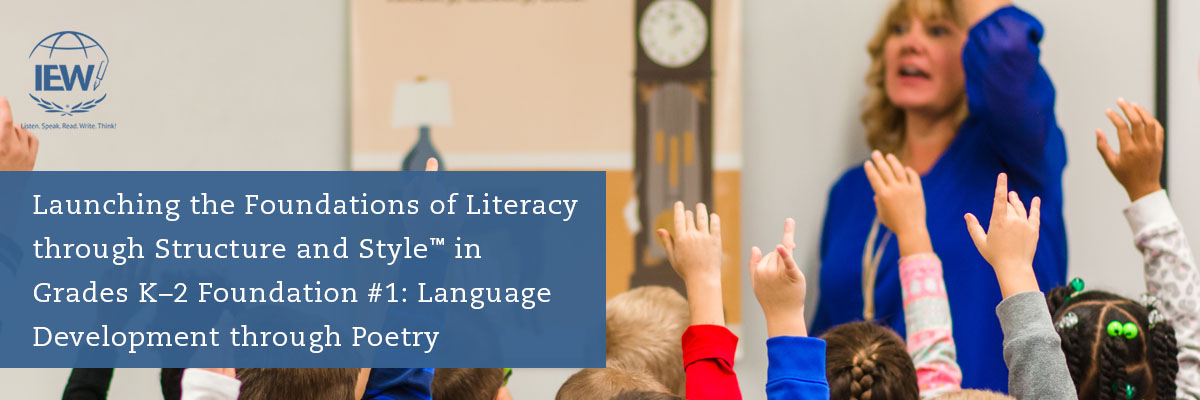
IEW’s instructional materials for the primary grades are based on the proven methods of the Institute for Excellence in Writing’s Structure and Style approach and are inspired by the language development activities of Anna Ingham's Blended Sound-Sight Program of Learning. This blending together of the ideas, mission, and vision of IEW’s founders has resulted in K–2 methods and materials that are both developmentally appropriate and highly effective. As K-2 teachers have happily exclaimed, “Finally, somebody understands primary writing!”
This four-part series illustrates how IEW’s K–2 methods and materials furnish the foundations of literacy necessary to grow young readers and writers. It begins in Part One with the key to it all: poetry.
Mrs. Ingham believed that poetry is the best way to expose children to the beauty of the spoken word. She understood that poetry not only develops a linguistically rich vocabulary; it’s the ideal medium to integrate learning. A poem becomes the launching point for oral language, vocabulary, comprehension, and so much more.
IEW’s Kindergarten, Grade 1, and Grade 2 Classroom Supplements were written with Anna Ingham’s methods at their heart and center. By using poetry as a springboard for each week’s lessons, language and literature are intentionally integrated with listening and speaking. Every lesson centers around the week’s selected poem, which is referenced and reinforced all week long. The rhythm, rhyme, imagery, and movement of the poem actively engage and delight the children in the lessons and build their language skills along the way. Through poetry study and memorization, children
- develop imagery
- cultivate a rich vocabulary
- learn correct sentence structure
- reinforce their reading skills
Another benefit? Poetry memorization improves the way children speak, which improves the way they write. How does this happen? Children tend to write the way they speak, so if we can improve the way they speak, we can improve the way they write. If a child cannot speak in complete sentences, he cannot write in complete sentences. If a child is not exposed to rich and expressive vocabulary, she won’t use it in her speech or in her writing. Teachers who used the primary Structure and Style materials have reported increased growth in their students’ language, reading, speaking, and writing skills. Teachers who work with English language learners report that their students’ sentence structures are improved and that their oral language is at a more complex, higher level.
Poetry also boosts reading comprehension. In the intermediate grades, comprehension is typically taught with longer pieces using longer stories, novels, and reading anthologies. IEW introduces it in the K–2 lesson plans with narrative poetry. A poem like “Little Jack Horner” contains a complete narrative story in one very short poem. It has a beginning, middle, and end and introduces a character quality. Was Jack really a good boy? Think of the lively discussion that will ensue in a classroom full of five-year-olds! Poetry begins to build a child’s moral imagination and reinforces good manners. Kindergarten teacher Jackie Hammond, IEW Featured Teacher of the Year for 2016, found that poetry activities helped her students’ reading skills soar because repeated exposure to narrative and informative poetry enabled them to organize data into sequences, into events, and into experiences that helped them to gather a sense of the poem and “put things together.”
The detailed lesson plans in the primary Classroom Supplements provide a template to follow, guiding the teacher to model conversations about poetry by asking questions that demonstrate how to discuss the poem and unpack its elements: Which words are unfamiliar? Can you find the verbs? Which words rhyme? Does the poem tell a story or give you information? How do you know? Besides filling young brains with rich and sophisticated language, these classroom conversations teach children how to interact with text and eventually help them internalize the process until they can interact with texts independently. This is a crucial skill as children move from the primary to intermediate grades.
Best of all? The poetry lessons are extraordinarily fun. Children engage with the poems, using their minds and their bodies. Teachers can’t help but see delight in their students’ faces, which confirms what primary teachers like Anna Ingham have always believed about the way young children learn. As Andrew Pudewa points out, “Children like to do what they can do, they want to do what they think they can do, and they hate to do what they cannot do.” In these moments when the love of language is ignited in her students, a teacher experiences a profound realization that good theory can meet best practice. IEW understands that primary writing is not only about learning to hold a pencil and learning new words but also about transferring a lifelong love of learning.
Primary Writing with Structure and Style was designed specifically with primary teachers in mind. Providing a bridge between Anna Ingham's Blended Sound-Sight Program of Learning and the Structure and Style writing method, this seminar serves as a springboard to literacy in the K-2 classroom.
If you would like more information about IEW’s training and classroom instructional materials for grades K–2, email Schools@IEW.com or call 800.856.5815.
Part two of this series will feature how IEW’s K–2 methods and materials nurture and strengthen the second foundation of language development: inherent grammar.
Other blog posts in this series:
Foundation 2: Building Grammar Skills through Poetry
Foundation 3: Teaching Phonics through Poetry
Foundation 4: Facilitating Composition through Handwriting Instruction and Copy Work
|
Jean brings 34 years of classroom experience to IEW, having taught grades 1–6 in New York, Virginia, and in California, where she taught sixth-grade language arts in the Rocklin Unified School District. She was introduced to IEW in 2001 when a colleague shared Student Writing Intensive videos at weekly school staff meetings. As a result of student progress and teacher enthusiasm at her school, RUSD brought Andrew Pudewa to Rocklin many times over the next several years to train district teachers, resulting in improved student writing and test scores district-wide. Named Rocklin’s “Elementary Teacher of the Year” in 2001, Jean was also included in the 2004 and 2005 editions of Who’s Who Among America’s Teachers. |

